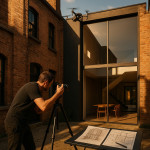Architecture photographer hiring checklist: align style, permits, deadlines
Hiring an architecture photographer is more than booking a camera-savvy creative. You need a pro whose visual style matches your brand, who can secure the right permits, and who never misses a construction milestone. Use this step-by-step checklist to minimise legal risks, keep budgets lean and receive striking images on time.
Why a checklist saves you budget and headaches

Architectural shoots often involve cranes, drone flights, traffic management and strict heritage rules. Overlooking one document or deadline can trigger costly reshoots. A documented checklist makes responsibilities clear and keeps the entire production—client, photographer and site team—on the same page.
1 – Verify visual style alignment
You want images that amplify your project narrative, not just pretty façades. Before you talk price, evaluate:
- Portfolio cohesion – Do colours, contrast and perspective echo your brand guidelines?
- Light handling – Is the photographer a master of natural light as outlined in this deeper guide to sun-path scheduling?
- Post-production approach – Check vertical correction, sky replacements and colour grading. For benchmarks, see post-production best practices.
- Niche techniques – Need drone panoramas or 3D render blends? Cross-reference with advanced drone workflows.
Tip: Insert a paragraph in your brief that states “reference gallery X” so the photographer knows exactly which look to replicate.
Quick style-fit test
- Send three of your favourite built project photos.
- Ask the photographer to annotate them: angle, lens, time of day.
- Review their terminology and suggestions for clarity and expertise.
2 – Secure permits and permissions early
Even the best photographer can be stopped by a clipboard-wielding site manager. Use the matrix below to plan paperwork at least four weeks ahead.
| Permit type | Needed for | Authority | Typical lead time | Budget range (€) |
|---|---|---|---|---|
| Public sidewalk occupancy | Tripods, cherry pickers, crew vans | City council | 10–15 days | 50–300 |
| Drone flight approval | Aerial stills & video | National aviation agency | 5–30 days | FREE–150 |
| Heritage building release | Protected façades, interiors | Cultural heritage board | 15–45 days | 100–600 |
| Private property consent | Neighbouring parcels, rooftops | Owner or facility manager | 2–7 days | 0–250 |
Delegate paperwork? Clarify in the contract which party submits each application. For granular tips, consult this site-scouting checklist.
3 – Map the timeline against construction milestones
Architectural photography revolves around light and site readiness. A delayed facade panel can kill a golden-hour slot. Build your schedule backwards from the publication date:
- T-8 weeks – Confirm project handover date with contractor.
- T-6 weeks – File permits, order cherry picker, lock in crew.
- T-4 weeks – Pre-visit for lighting tests and final shot list.
- T-2 weeks – Final cleaning, remove signage, touch-up paint.
- Shoot day – Capture dawn, mid-day, dusk if budget allows.
- T +1 week – Receive contact sheet, select hero images.
- T +3 weeks – Approve retouching, deliver hi-res files.
Share this roadmap with the site manager and marketing team to secure access and avoid clashes with snagging works.
4 – Draft a contract that protects both sides
A solid agreement prevents scope creep and copyright confusion.
- Deliverables – Number of final images, resolution, file format.
- Usage rights – Define channels and territories. Unlimited digital use often excludes billboard campaigns.
- Revision rounds – Two rounds are industry standard.
- Payment terms – 50 % deposit, 50 % on delivery keeps everyone motivated.
- Force majeure & weather clause – Reschedule without extra fee if rain makes shots impossible.
- Permit responsibility – Spell out who pays and files each application.
Need a template? Head to this contract resource for copy-paste clauses.
5 – Build a transparent budget
Surprise invoices strain relationships. Itemise costs early:
- Photographer day rate
- Assistant and drone operator
- Equipment hire (tilt-shift lenses, lift)
- Permits and location fees
- Travel and accommodation
- Retouching hours
Ask your photographer to isolate hard costs on a separate line so finance teams can compare bids quickly.
6 – Maintain real-time communication
Use shared cloud folders and instant-messaging channels. Agree on response times—e.g., 24 hours for non-urgent questions, 2 hours on shoot day. A clear communication ladder stops minor hiccups from snowballing into delays.
7 – Plan delivery, backup and archiving
Storing high-resolution files securely is part of the job.
- File naming convention – ProjectCode_Date_ShotNumber.
- Delivery method – Cloud gallery with download receipts.
- Backup policy – Photographer keeps RAW files for at least five years.
Future marketing teams will thank you when they can still retrieve the hero dusk shot in 2029.
Interactive quiz: Are you contract-ready?
CTA: Book photographers who tick every box
Ready to shortlist professionals who already master these steps? Browse the curated architecture photographer directory on Artfolio and message talents that align with your timeline today.
FAQ
- How early should I book an architecture photographer?
- Secure your photographer 6–8 weeks before site handover to lock in permits and optimal light slots.
- Can one photographer handle both drone and ground shots?
- Many professionals hold drone licences, but confirm credentials and insurance. Otherwise, hire a specialist operator.
- What resolution is standard for magazine print?
- Print editors usually require 300 dpi TIFF files at A3 size or larger. Include a CMYK version for colour accuracy.
- Who owns the copyright?
- By default, the photographer does. Your contract should grant specific usage rights or full buyout if needed.
Next step: Download this checklist, share it with your project team, and hit “send” on that enquiry email before golden hour slips away.











